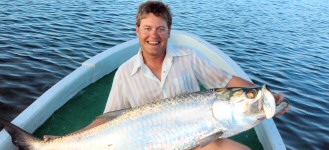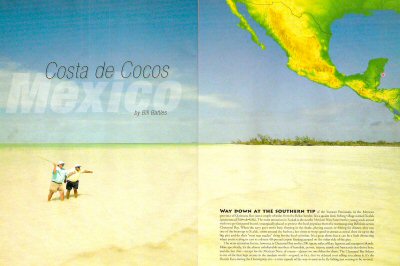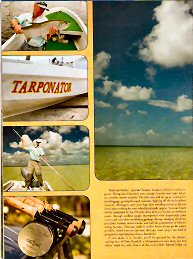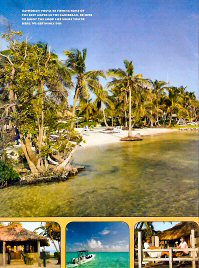FLY FISH AMERICA | BILL BATTLES
Costa de Cocos - Mexico
WAY DOWN AT THE SOUTHERN TIP of the Yucatan Peninsula, in the Mexican province of Quintana Roo just a couple of miles from the Belize border, lies a quaint little fishing village named Xcalak (pronounced Eshecahelahk). The main attraction in Xcalak is the nearby Mexican Navy base (twelve young studs armed with two go-fast patrol boats), strategically placed to protect the local populace from the warmongering Belizeans across Chetumal Bay. When the navy guys aren’t busy sleeping in the shade, playing soccer, or fishing for dinner, they run one of the boats up to Xcalak, zoom around the harbor a few times at warp speed to attract a crowd, then tie up to the big pier and do their “muy mas macho” thing for the local senoritas. It’s a great show, but it can be a little distracting when you’re trying to cast to a dozen 40-pound tarpon fining around on the other side’ of the pier. The main attraction for me, however, is Chetumal Bay and its 200 square miles of flats, lagoons and mangrove islands.
More specifically, it’s the almost unbelievable numbers of bone fish, permit, tarpon, snook and barracuda that thrive here, and the fact that-except for the Mexican Navy, of course-almost no one fishes for them. The Chetumal Bay fishery is one of the best kept secrets in the modern world-so good, in fact, that we debated even telling you about it. It’s the Florida Keys during the Hemingway era-a time capsule of the-way-it-used-to-be fly fishing just waiting to be savored.
“How can this be,” you ask? Simple. Xcalak is a bitch of a place to get to. Flying into Cancun is easy enough, bur the next eight hours are another matter entirely. The first two will be spent waiting for your luggage, getting through customs, fighting off the six hundred “porters” offering to carry your bag, then standing in line at the car rental place waiting for your wheels to actually appear. Six more hours will be consumed by the 250 mile drive down to Xcalak on mediocre roads, through endless jungle interspersed with desperately poor towns and countless smoldering garbage dumps, dodging chickens, pot holes, broken down trucks, and half the population of Mexico riding bicycles. (You Can make it in five hours if you go 80 where possible, which you can, because the cops won’t stop a van load of gringos for anything less than a hundred.)
If you make it to Xcalak, you’ll be greeted by the always smiling face of Dave Randall, a Minnesota rat-race drop our and owner (with his wife, Ilana) of the nicest little fishing lodge on earth-Costa de Cocos. The first thing you’ll get is a drink (Dave knows his priorities), then a quick inspection of your private, palapa-roofed cabana (with two double beds, ceiling fans, en suite bath and 24-hour electricity), followed by a gourmet dinner in the open-air dining room. Evenings, of course, are spent at the bar, or on the beach-front deck adjacent thereto.
So how did we find this place? Actually, we didn’t. It was found for us by Magnus Gunnarsson, head man at Svendsen Sport USA, who invited us down there last January to test and evaluate Scierras new saltwater gear. The fishing was simply outstanding-the best I’ve ever had in Mexico-and Costa de Cocos proved to be a little gem of a lodge. Out first day started off with a whopping breakfast, followed by a get together with our guides to plan the day. That’s right, the guides speak English and they let you decide what you want to fish fot. It takes me a day or so to acclimate to the heat and get my “flats eyes” working, so we opted for bonefish as a good warm-up quarry. By 9:00 AM we were rigged and aboard the pangas (20- to 22-foot real boats with huge, recessed casting decks that get you there and back dry and alive) ready for the 20-minute run to the first lagoon on the day’s itinerary.
As we nudged up onto the beach that separated the target lagoon from the bay, Trapper Rudd spotted a big, solitary bone working down the edge of the beach toward us. Even though he earns his keep as a Rocky Mountain fly shop owner and trout guide (www.cutthroatanglers.com), Trap is an absolute flats animal, and had a shrimp pattern in the air before the rest of us figured out what was happening. The fly dropped down 80 feet out, about 15 feet ahead of the fish and right on his line of approach. I couldn’t have done it better myself. Thirty seconds later an almost-lO-pound bone erupted from the shallows and blew straight out toward the reef. He put Trap into his backing four times over the next ten minutes before finally coming to hand-a great start to what would prove to be a fantastic four days at Costa de Cocos. We took six or seven bones out of the first lagoon before that school totally freaked out, then headed off to the next of countless bonefish hot spots. More big singles were taken, but what impressed me most was the sheer number of fish we saw. Schools of several hundred fish stood out like black clouds against the white sand bottom, and after catching all the bonefish we could handle we started to make a game out of dropping our flies directly over the center of the cloud. It was a huge kick seeing hundreds of fish blowing off in all directions, but the big surprise was that every time we did it we still hooked a fish!
Over the next three days we covered dozens of square miles of Chetumal Bay, but didn’t even come close to seeing the whole thing. What we did see, however, were a number of firsts for all of us. Have you ever seen a school of several hundred bonefish with 40 permit mixed in, some of which topped 35 pounds? In all the years I’ve fished, I’d never seen anything like that before, but it was a scene that repeated itself day after day. We were never able to extract one of those communal permit because a bone always grabbed the fly first, but had no trouble hooking up with plenty of others out of smaller schools in channels and in deeper water off the beaches. We had about 50 different crab patterns among us, but the only flies they’d take were the ones the guides picked out.
And then there were the snook in the mangrove lagoons; the resident tarpon in interior “ponds” accessible only through mile-long tunnels through the mangroves; and our second trip to Costa de Cocos in May for huge migratory tarpon in the channels. Perhaps I talk too much-as my wife asserts-but I’m almost out of space here, so those tales have to be saved for another day.
BILL BATTLES is the executive publisher of Fly Fish America.



